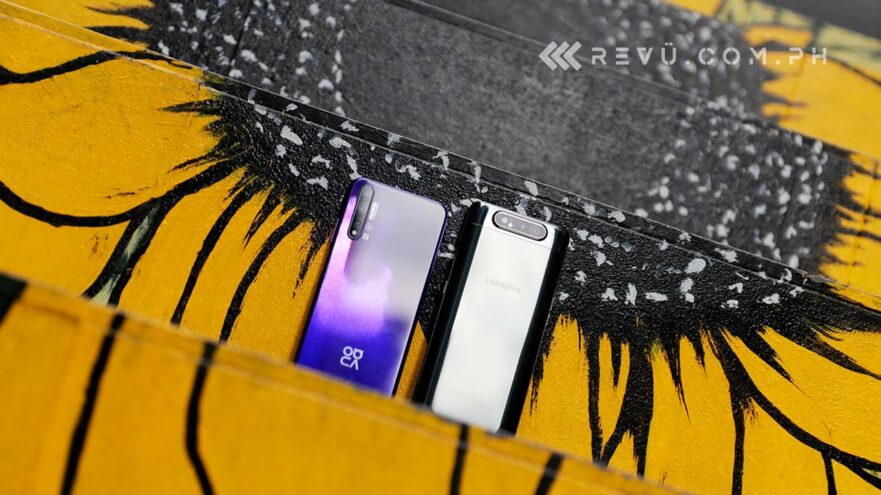The Huawei Nova 5T and Samsung Galaxy A80 are two of the most specced-out premium midrange handsets out there vying for your attention.
(Update, October 30: We’ve also compared the Nova 5T with the Vivo phone with six cameras. Read Huawei Nova 5T vs Vivo V17 Pro: Battle of the full-screen phones.)
But how well do these devices stack up against each other? In this article, we’re going to compare the specs and features of the Nova 5T with Samsung’s first phone with a pop-up camera to help you decide which one you should consider buying.
Design: 2 different paths to a full screen
Full-screen phones are quite common now, not just in the high-end luxury category, and both Huawei and Samsung have thrown their hats into the ring to keep with the trend. The Huawei Nova 5T and Samsung Galaxy A80 feature bright and beautiful screens that extend to the sides, although they differ in some key ways.
The Nova 5T has a 6.26-inch LCD with a 19.5:9 screen ratio, whereas the Galaxy A80 arrives with a taller, wider 6.7-inch Super AMOLED display with a 20:9 ratio, which gives the phone a larger footprint than the Huawei phone.
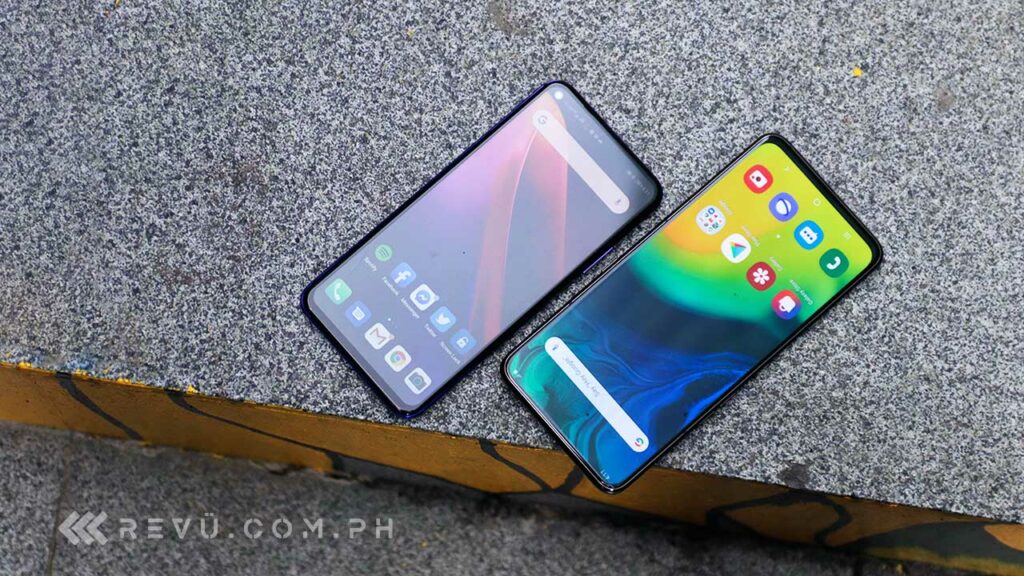
The Samsung Galaxy A80 has a larger footprint than the Huawei Nova 5T
The Galaxy is thicker and heavier, too, making it harder to carry around, even with its curved back design. By contrast, the Nova is easier to handle with one hand, in portrait or landscape position, despite incorporating metal and glass into its exterior like the Galaxy A80.
Another key difference is that the Huawei Nova 5T has a punch-hole cutout for the selfie camera, while the Galaxy A80 doesn’t have anything on the front to distract from your viewing experience. The phone has its cameras tucked away in a motorized pop-up module with questionable durability.
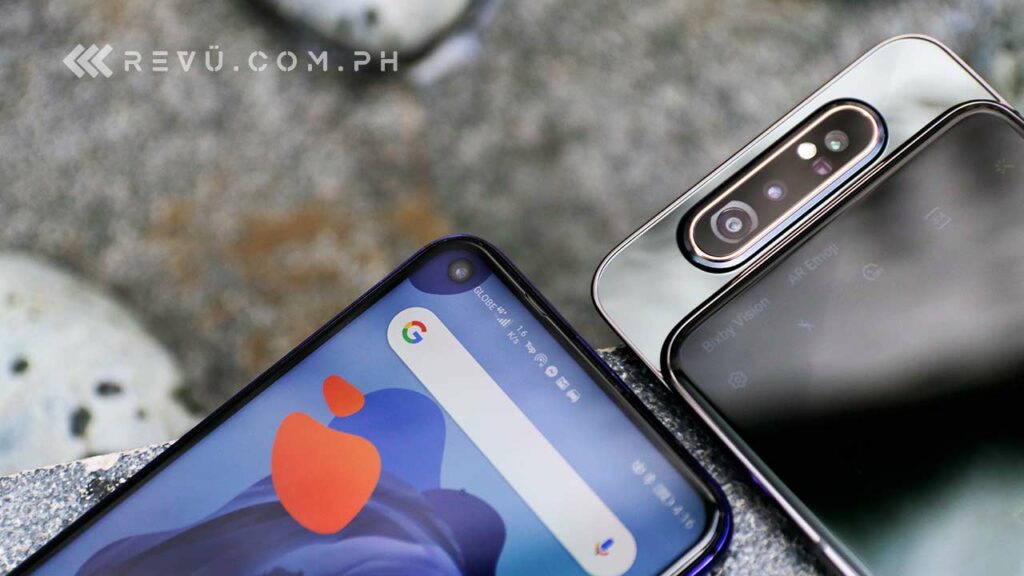
The Huawei Nova 5T has a punch-hole cutout for the selfie camera while the Samsung Galaxy A80 has its cameras tucked away in a motorized pop-up module
To take a selfie using the A80, the main and secondary cameras rotate forward and backward on the module, so there are actually two motors that work in tandem, and that means less room for error than a standard pop-up system.
It’s no doubt an ingenious approach to get rid of notches and cutouts while delivering better pictures and videos regardless of where the screen is facing in the process. However, the execution is questionable, as we found the camera module to be flimsy and possibly susceptible to mechanical failure, especially when it is elevated and facing the user.
Unlike Samsung, Huawei’s path to an edge-to-edge display is much more discreet, yet just as effective for most people, including us. The cutout at the top-left corner is small, just enough for the camera lens to poke through. No motors and moving parts to power the camera means less things to worry about when you carry the handset around.
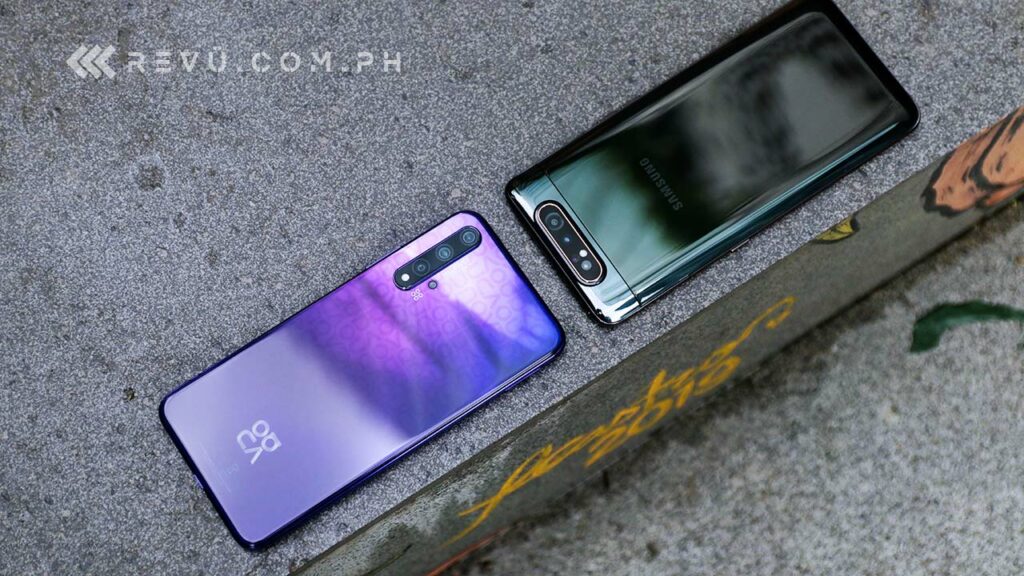
The rear design of the Huawei Nova 5T stands out more
Both phones do look good, and the ergonomics are great too, although the rear design of the Huawei Nova 5T stands out more, which you might not expect given the Samsung Galaxy A80’s hefty price tag. The two devices carry fingerprint sensors as well, but we found the one on the side of the Nova 5T to be a bit faster and more precise than Samsung’s in-screen solution.
Camera: 5 AI cameras vs a motorized, one-size-fits-all camera
With each Nova release, Huawei has continued to refine and improve the camera experience year after year. The Nova 5T represents the best it has to offer in the category and packs four cameras on the back and one in front to give users the versatility needed to shoot any scene.
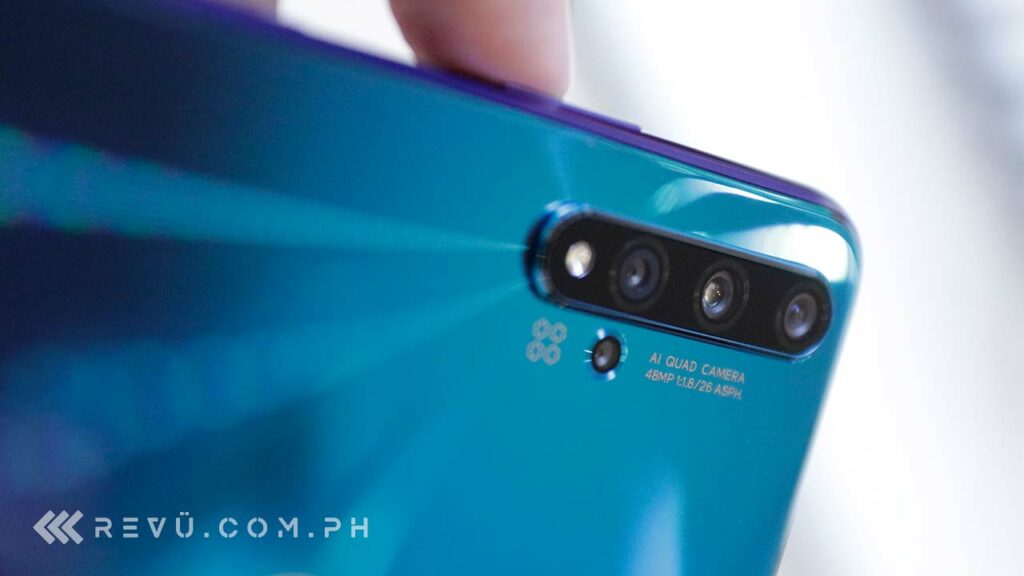
The Huawei Nova 5T’s four cameras on the back (unit seen here is the Crush Blue color variant, not Midsummer Purple)
Need to take pictures in low light? The main camera shoots up to 48 megapixels and uses a technique called pixel binning to combine four pixels’ worth of data into one. This allows the sensor to produce a brighter and more detailed image with the help of software algorithms.
Like shooting landscapes and skyscrapers? Use the 16-megapixel secondary camera with an ultra-wide, 13mm-equivalent lens to get the widest view possible and get more of the scene in the frame.
SEE ALSO: Look: We’ve updated our Huawei Nova 5T to Android 10
The Huawei Nova 5T also gets twin 2-megapixel sensors for portrait and macro purposes. Not only that, there’s a dedicated Night mode in the viewfinder to brighten up images with just the right amount of exposure and sharpness. It works with the main and ultra-wide cameras.
The front-facer of the latest Nova houses a 32-megapixel sensor, which has one of the highest pixel counts you’ll find in a selfie camera. As expected, it snaps crisp and detailed images in daylight and comes with a number of filters and effects that you can apply in real time. Selfie lovers should have fun with this camera.
[sciba leftsrc=”https://www.revu.com.ph/wp-content/uploads/2019/10/Huawei-Nova-5T-sample-1x-picture-review-Revu-Philippines.jpg” leftlabel=”Huawei Nova 5T” rightsrc=”https://www.revu.com.ph/wp-content/uploads/2019/10/Samsung-Galaxy-A80-sample-1x-picture-review-Revu-Philippines.jpg” rightlabel=”Samsung Galaxy A80″ mode=”horizontal” width=””]
Daytime shots
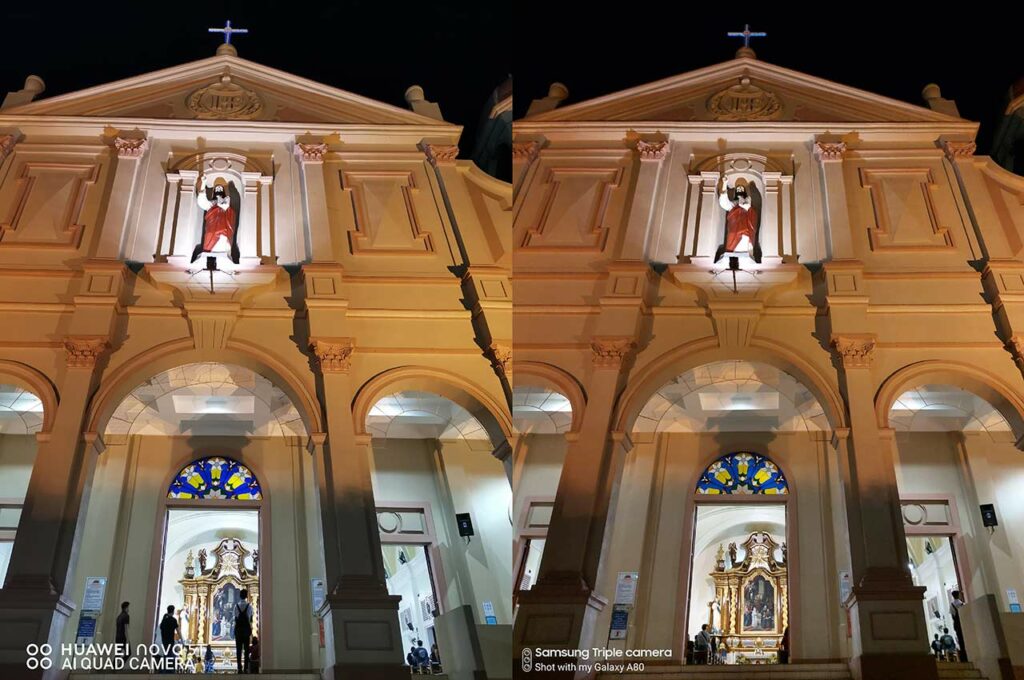
Night shots
2nd set of photos taken in Auto mode at night
Ultra-wide pictures captured in the daytime
Another set of ultra-wide pictures
At night this time
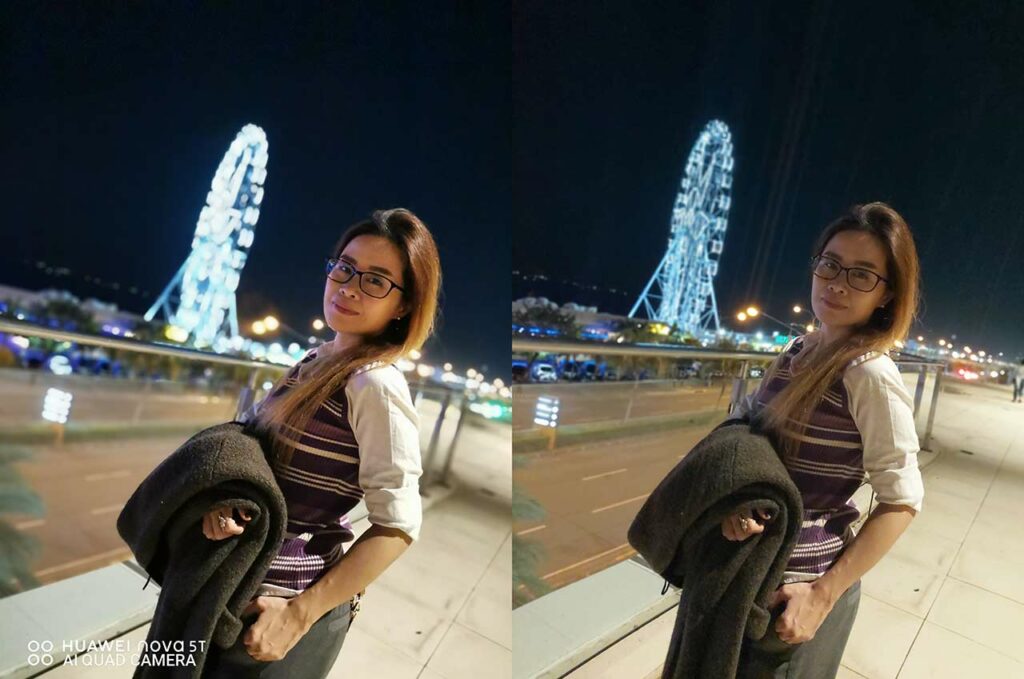
Portraits… in portrait mode
For taking pictures with the primary camera, the Samsung Galaxy A80 uses a 48-megapixel sensor that is used to shoot pixel-binned images as well. The pop-up module is also equipped with an ultra-wide camera, but with 8 megapixels only, so the details look a bit soft especially when blown up on a monitor. Rounding out the camera package is a time-of-flight or TOF sensor to improve portrait photography and add background blur to videos.
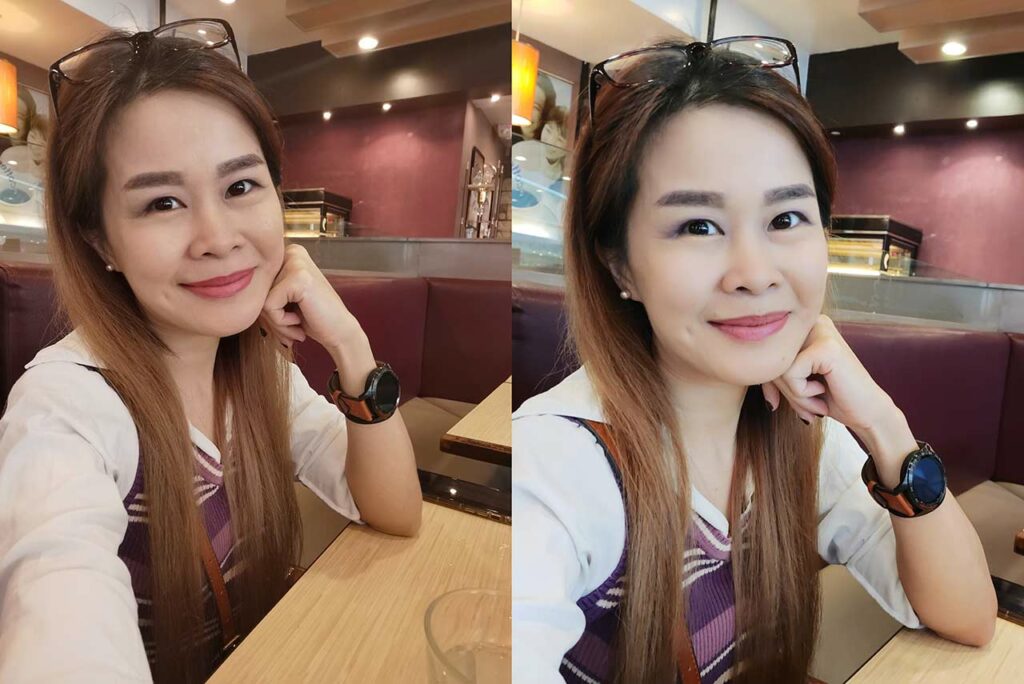
Huawei Nova 5T vs Samsung Galaxy A80: Selfies taken indoors in the daytime
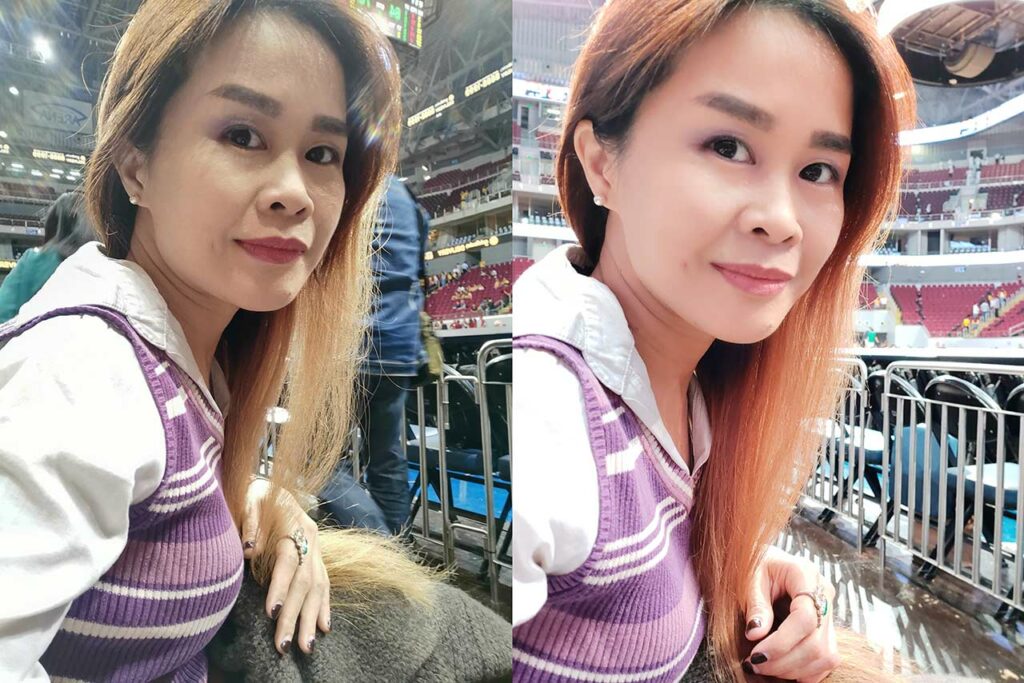
Huawei Nova 5T vs Samsung Galaxy A80: Selfies shot indoors at night but with harsh background light
These same set of cameras are activated to snap selfies and videos (because, again, they flip forward and backward), so the ultra-wide shooter can be used for group selfies, whereas the TOF sensor adds a blur effect around a subject in Live Focus mode. The Galaxy A80 doesn’t have a macro sensor.
This Samsung delivers good photos in the daytime, but struggles with noise and dynamic range in night shots, unlike the Nova 5T. Side-by-side photo comparisons reveal some odd coloring at the edges and Night mode isn’t as bright as on the Huawei.
Performance: HiSilicon Kirin 980 vs Qualcomm Snapdragon 730
One of the biggest strengths of the Nova 5T is its powerful computing and graphics-processing performance that is made possible by Huawei’s top-end HiSilicon Kirin 980 chipset. Notably, it’s the same chip seen previously in the Huawei Mate 20, Mate 20 Pro, P30, and P30 Pro, and this time around, it’s paired with 8GB RAM for smooth multitasking and 128GB of native storage to store your files and media.
The Kirin 980 is fabricated using a 7nm process, which lets the company improve efficiency and push up the CPU speeds. It incorporates a 10-core Mali-G76 GPU, which is again built with 7nm technology and is said to deliver a 40% performance boost from the previous generation.
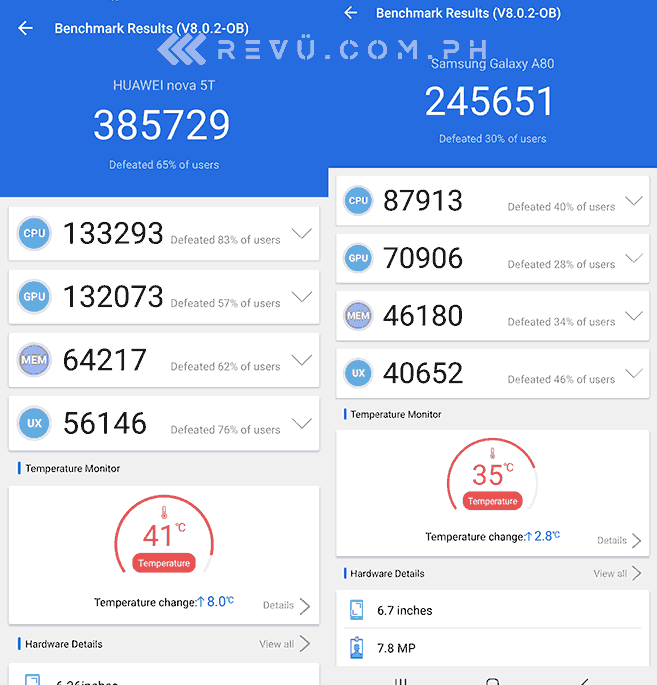
Benchmark scores in version 8 of Antutu app
The Samsung Galaxy A80 has a newer chip that also comes with 8GB of RAM and 128GB of storage, but it’s a midrange Qualcomm Snapdragon 730 that uses an 8nm process. It’s powerful enough to run almost any app you’d want to run, including graphics-intensive games like NBA 2K20 and Call of Duty: Mobile, but it’s not quite as powerful — or efficient — as the Nova 5T’s Kirin 980.
Though both offer silky-smooth performance in day-to-day tasks, the Huawei Nova 5T is more future-proof and capable of handling the next wave of demanding games that will require better hardware to play smoothly.
Battery and charging: Too close to call?
The Nova 5T is powered by a 3,750mAh battery, which has a higher capacity than the 3,700mAh cell inside the Galaxy A80. Both offer fast wired charging over USB-C, though the Galaxy A80 gets a slight advantage with its 25-watt power brick. The Nova 5T’s battery backup can reach 22 watts using the included charger and cable.
Due to its smaller screen and power-efficient Kirin processor, though, the Nova 5T can last longer on a single charge. The battery life of the Galaxy A80 doesn’t quite match up to that of the Huawei phone, but it’s decent enough to get you through a full day with moderate usage.
Pricing: A gap too wide to be ignored
For all its premium features, the Huawei Nova 5T only costs P18,990, around $370 converted. The Samsung Galaxy A80, on the other hand, retails at P34,990 ($682), or almost double the cost of its rival. That is a substantial price difference between two phones that are not so different from one another. In many ways, the Nova 5T is even a better purchase.
If you are a gamer and are looking for a handset entirely for gaming purposes, the Huawei handset will give you a much smoother experience. For camera enthusiasts, the Night mode on the Nova 5T will provide you with clearer photos at night or in low-light situations.
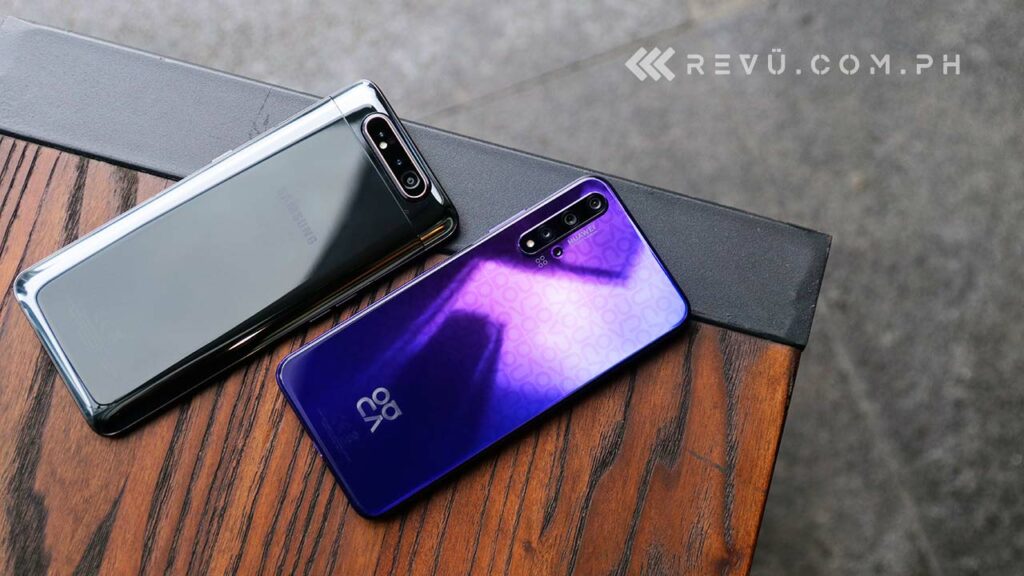
Samsung Galaxy A80 or Huawei Nova 5T?
Final thoughts
With the Huawei Nova 5T, the company has introduced a flagship-grade smartphone that won’t burn a hole through your budget. A (mostly) full-screen experience, five cameras for just about any shooting scenario, butter- smooth performance, long battery life, and fast charging — the latest Nova has it.
The Samsung Galaxy A80’s highlights include a big and bold display and a fancy camera system that includes a ToF sensor for better portraits. But it also has a huge price tag to match, and it’s nowhere near as comfortable to use either. While the Galaxy A80 is a good midrange option, it’s certainly not for everyone, least of all those with a budget ceiling like most of us.
The Huawei Nova 5T is the winner of this comparison.
Huawei Nova 5T specs
- 6.26-inch IPS LCD display, 2,340 x 1,080 resolution, 19.5:9 aspect ratio
7nm octa-core Kirin 980 processor - 8GB RAM
- 128GB storage
- Quad: 48MP, f/1.8 main camera (Sony IMX586); 16MP, f/2.2 ultra-wide camera; 2MP, f/2.4 macro sensor; 2MP, f/2.4 depth sensor
- 32-megapixel, f/2.0 front camera
- Fingerprint reader (side-mounted)
- 3,750mAh battery with 22.5-watt fast wired charging
- EMUI 9.1 based on Android 9.0 Pie (upgradable to EMUI 10-based Android 10)
- Colors: Crush Blue, Midsummer Purple, Black
Samsung Galaxy A80 specs
- 6.7-inch Super AMOLED display, 2,400 x 1,080 resolution (20:9)
- Octa-core Qualcomm Snapdragon 730 processor
- 8GB RAM
- 128GB non-expandable storage
- Sliding, rotating triple 48MP, 8MP (ultra wide), TOF 3D rear cameras
- Fingerprint sensor (in-screen)
- 3,700mAh battery with 25-watt USB-C charging
- Samsung One UI on Android 9.0 Pie
- Colors: Angel Gold, Ghost White, Phantom Black
Share this Post


